When it comes to determining the ideal temperature for dogs to hike or walk outside, there is no one-size-fits-all answer. Factors such as wind chill, snow conditions, breed, size, age, and health all play a role. You should pay attention to your dog’s signals and adjust accordingly.
Veterinarians suggest that most healthy medium or large dogs can walk for 30 minutes if the temperature is above 20 degrees F, while smaller dogs should limit their walk to 15 or 20 minutes in temperatures between 20 to 32 degrees F. However, if the temperature drops below 0 degrees, it is advised to keep all dogs indoors. Puppies and older dogs are particularly sensitive to the cold, and dogs with certain physical conditions should be kept in a warm environment. You might want to be aware of signs of discomfort, hypothermia, and frostbite in dogs and to adjust their activities accordingly.
Key Takeaways:
- The ideal temperature for dogs to hike or walk outside varies depending on factors such as breed, size, age, and health.
- Most healthy medium or large dogs can walk for 30 minutes if the temperature is above 20 degrees F.
- Smaller dogs should limit their walk to 15 or 20 minutes in temperatures between 20 to 32 degrees F.
- If the temperature drops below 0 degrees, it is advised to keep all dogs indoors.
- Puppies, older dogs, and dogs with certain physical conditions are more sensitive to the cold and should be kept in a warm environment.
Factors Affecting Safe Outdoor Temperatures for Dogs
When determining the safe outdoor temperatures for dogs to hike or walk, several factors come into play. These factors include wind chill, moisture levels, breed, age, size, and the overall health of the dog. Wind chill can significantly lower the feel of the actual temperature, making it more uncomfortable for dogs. Wet snow or other forms of moisture can also cause a faster decrease in the body temperature of dogs. Different breeds have varying tolerance levels to cold weather, with certain breeds having thicker coats for added protection. Puppies and older dogs are more susceptible to the cold due to their inability to regulate their body temperature effectively. By considering these factors, dog owners can make informed decisions about their outdoor activities and take appropriate precautions to ensure the safety and well-being of their furry companions.
Factors Affecting Safe Outdoor Temperatures for Dogs
Factors that impact the safe outdoor temperatures for dogs include:
- Wind chill
- Moisture levels
- Breed
- Age
- Size
- Overall health
Wind chill can make the temperature feel colder than it actually is, making it uncomfortable for dogs. Moisture, such as wet snow, can accelerate the decrease in body temperature. Different breeds have varying levels of tolerance to cold weather, and some breeds have thicker coats that provide additional protection. Puppies and older dogs are more sensitive to the cold due to their difficulty in regulating body temperature effectively. Considering these factors is essential for ensuring the safety and well-being of dogs during cold weather hikes.
| Factors | Impact on Safe Outdoor Temperatures |
|---|---|
| Wind chill | Significantly lowers the feel of the actual temperature |
| Moisture levels | Faster decrease in body temperature |
| Breed | Varying tolerance levels; some breeds have thicker coats for added protection |
| Age | Puppies and older dogs are more susceptible to the cold |
| Size | No specific impact on safe outdoor temperatures, but smaller dogs may lose heat more quickly |
| Overall health | Health conditions can make dogs more sensitive to the cold |
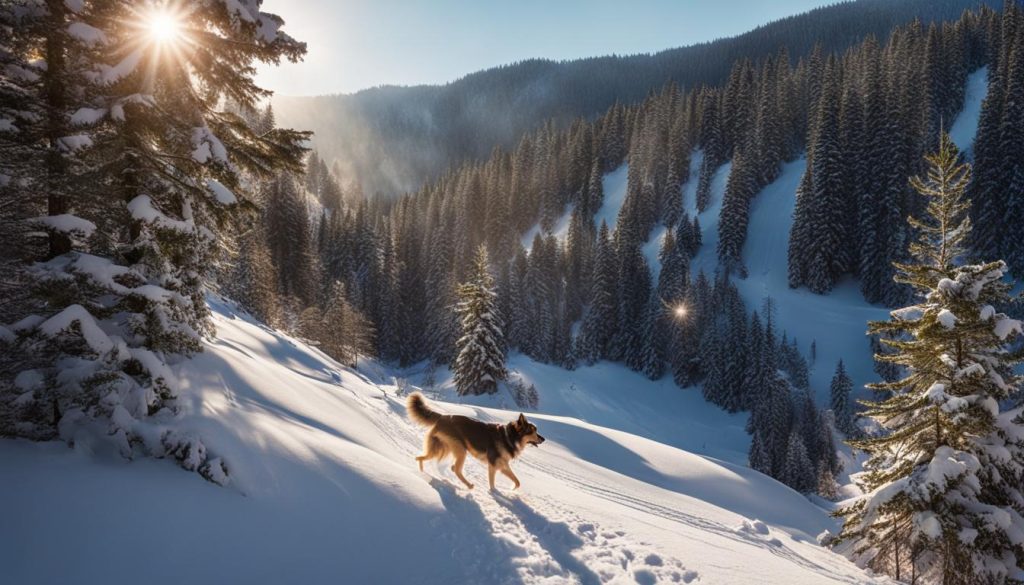
Understanding the factors that affect safe outdoor temperatures for dogs is crucial for their safety and well-being during cold weather hikes. By being aware of wind chill, moisture levels, breed, age, size, and overall health, dog owners can make informed decisions and take appropriate measures to protect their furry friends. Try to always prioritize the comfort and safety of your dog when venturing out into cold weather conditions.
Signs of Hypothermia and Frostbite in Dogs
Knowing the signs of hypothermia and frostbite in dogs is crucial when it comes to keeping them safe in cold weather. Dogs are susceptible to these conditions, and early recognition can help prevent further complications. Here are some signs to watch out for:
Hypothermia:
- Shivering
- Standing in a hunched position
- Lifting paws off the ground
- Whining or barking
- Lethargy
- Weakness
- Slowed breathing
Frostbite:
- Pale or blue-colored areas, such as the tail, paws, and ear tips
If you notice any of these symptoms, bring your dog indoors and seek veterinary attention. Do not attempt to warm up the dog too quickly, as it can lead to further complications. Instead, wrap your dog in warm blankets and gradually increase their body temperature. To put it simply, prevention is key, so always monitor your dog’s comfort level and adjust their activities accordingly to protect them from hypothermia and frostbite.
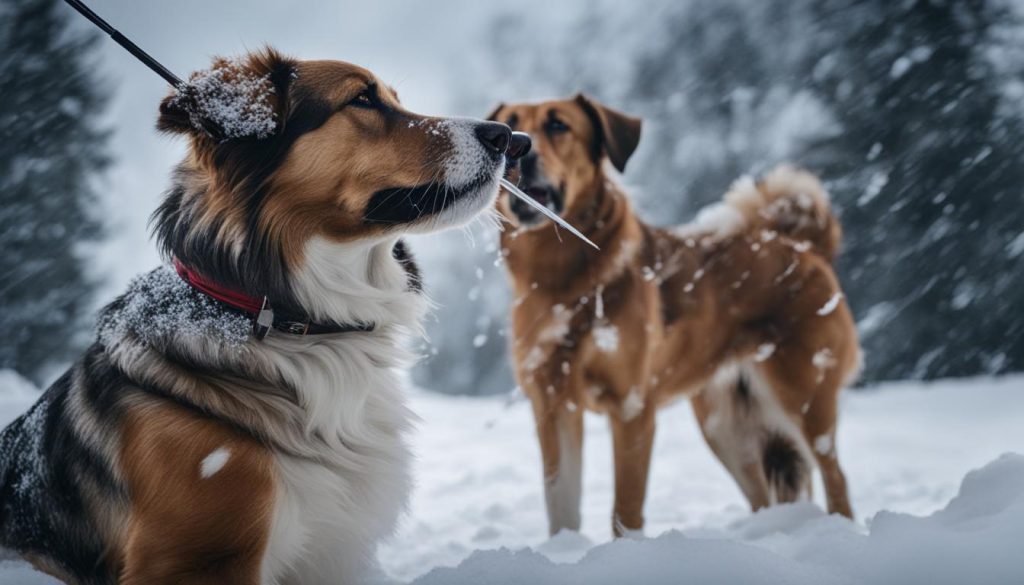
Protective Gear for Cold Weather Hiking
In cold weather hiking, it is good practice to provide dogs with protective gear to ensure their comfort and safety. One essential piece of gear is dog boots. These boots protect their paws from cold surfaces, ice, snow, and salt, preventing discomfort and reducing the risk of frostbite. Dog boots also prevent the accumulation of ice and snow between the toes, which can cause irritation and pain. When choosing boots, you should find ones that fit well and provide insulation to keep the paws warm.

In addition to boots, dogs with short hair or small breeds can benefit from wearing a sweater or jacket to provide extra warmth. These garments help trap the dog’s body heat and protect them from the cold. You should choose jackets that are well-fitted and made from insulating materials. By providing dogs with the appropriate protective gear, owners can ensure that their furry companions can enjoy outdoor activities even in colder temperatures.
Furthermore, if you are planning to hike in areas with extreme cold or deep snow, consider investing in snow goggles for your dog. These goggles protect their eyes from the harsh cold and glare of the snow, reducing the risk of snow blindness. Snow goggles are particularly beneficial for breeds with sensitive eyes or those prone to eye conditions.
Table: Comparison of Popular Dog Boot Brands
| Brand | Features | Price Range |
|---|---|---|
| Pawz Dog Boots | – Disposable and biodegradable – Waterproof and durable – Excellent grip and traction |
$10-$20 per pack |
| Ruffwear Grip Trex Boots | – Vibram outsole for traction – Breathable mesh upper – Secure hook-and-loop closure |
$75-$85 per set |
| Muttluks Original Fleece-Lined Dog Boots | – Fleece-lined for warmth – Self-tightening straps for secure fit – Reflective accents for visibility |
$40-$60 per set |
You should note that not all dogs readily accept wearing boots or jackets. Introduce the gear gradually and associate it with positive experiences, such as treats and praise. Practice short walks indoors before venturing outside to ensure the dog is comfortable and properly adjusted to the gear. If your dog still resists wearing boots or jackets, consider alternatives such as wax-based paw protectants or warming balms that can help shield their paws from the elements.
Importance of Breed and Coat Type in Cold Weather Hiking
When it comes to cold weather hiking, the breed and coat type of a dog play a significant role in their tolerance to winter weather. Certain breeds have better natural insulation and protection against cold temperatures. For example, dogs like German Shepherds, St. Bernards, and Akitas have thick coats that provide extra insulation and warmth. These breeds are generally more equipped to handle winter conditions and may have a higher tolerance for colder temperatures.
On the other hand, small dogs and dogs with short hair may have less natural insulation and are more susceptible to the cold. These dogs may require additional protection to keep them comfortable and safe during cold weather hikes. Providing them with a sweater or jacket can help provide extra warmth and prevent heat loss. I recommend that you choose clothing that fits well and provides adequate insulation without restricting movement.
Understanding the specific needs of different breeds and their coat types is essential for making informed decisions about outdoor activities in cold weather. By taking the breed and coat type into consideration, dog owners can ensure that their furry companions stay warm, comfortable, and safe during cold weather hiking adventures.
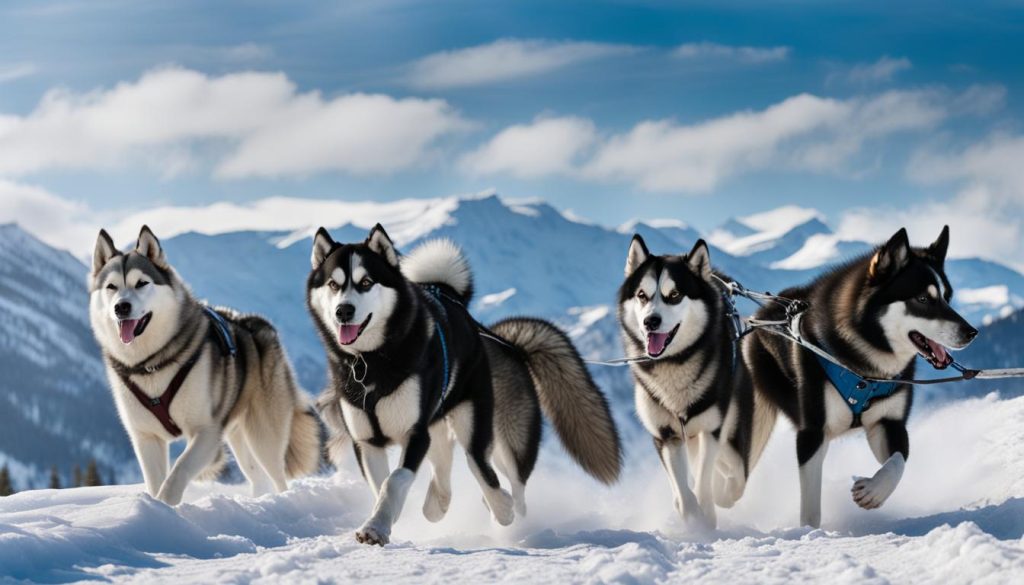
Special Considerations for Dogs with Health Conditions
When it comes to cold weather activities, dogs with health conditions such as arthritis and hip dysplasia require special considerations to ensure their well-being. These conditions can be aggravated by the cold temperatures, leading to increased discomfort and stiffness. As a responsible dog owner, you should prioritize their comfort and take proactive measures to keep them safe and content.
Dogs with arthritis and hip dysplasia should be kept indoors in a warm and cozy environment during cold weather. The cold can cause their joints to become more painful and inflamed, making it difficult for them to move comfortably. By providing a warm indoor space, you can help alleviate their discomfort and minimize the risk of further joint damage.
While outdoor activities may be limited, it is essential to provide alternative opportunities for physical and mental stimulation. Puzzle toys, interactive games, and obedience training can help keep their minds sharp and engaged. Additionally, gentle exercises such as swimming or hydrotherapy can be beneficial for dogs with arthritis or hip dysplasia, as they provide low-impact exercise that helps to improve mobility and strengthen joints.
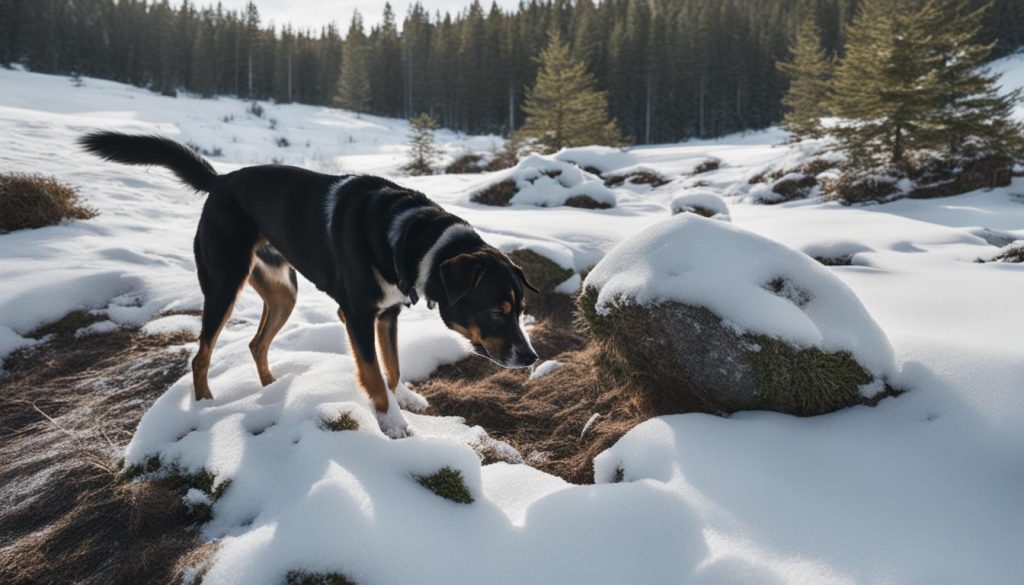
Regular veterinary check-ups are also crucial for dogs with these health conditions, especially during the colder months. Your veterinarian can provide guidance on managing their pain, adjusting medications if necessary, and ensuring their overall well-being.
Table: Recommended Activities for Dogs with Arthritis and Hip Dysplasia in Cold Weather
| Activity | Description |
|---|---|
| Indoor puzzle toys | Provide mental stimulation and help keep dogs engaged. |
| Interactive games | Play games that encourage physical and mental activity, such as hide-and-seek or treat puzzles. |
| Obedience training | Keep their minds sharp and provide a sense of accomplishment. |
| Swimming or hydrotherapy | Low-impact exercises that help improve joint mobility and strength. |
By understanding the unique needs of dogs with health conditions and taking appropriate measures, you can ensure that they stay comfortable, active, and happy during the colder months. Try to consult with your veterinarian for personalized advice and guidance based on your dog’s specific condition and needs.
Cold Weather Safety Tips for Dogs
When embarking on outdoor activities with your dog in cold weather, it is good practice to prioritize their safety and well-being. Here are some cold weather safety tips to keep in mind:
- Dress your dog in protective gear: Consider using dog boots to protect their paws from cold surfaces, ice, snow, and salt. Additionally, dogs with short hair or smaller breeds may benefit from wearing a sweater or jacket to provide extra warmth.
- Monitor wind chill and adjust activities: Wind chill can significantly affect how dogs perceive the temperature. Be aware of the wind chill factor and adjust outdoor activities accordingly. If wind chill makes it too cold for comfort, consider shortening the duration of walks or finding alternative indoor activities.
- Be aware of your dog’s limits: Every dog is unique, so pay attention to their individual tolerance to cold weather. Watch for signs of discomfort, such as shivering, lifting paws off the ground, or exhibiting signs of fatigue. Respect their limits and bring them indoors to a warm environment if necessary.
- Know the signs of hypothermia and frostbite: Familiarize yourself with the signs of hypothermia and frostbite in dogs. If you notice any symptoms, such as shivering, lethargy, or pale/blue extremities, seek veterinary attention immediately.
By following these cold weather safety tips, you can ensure that your dog stays comfortable and protected during outdoor activities in colder temperatures.
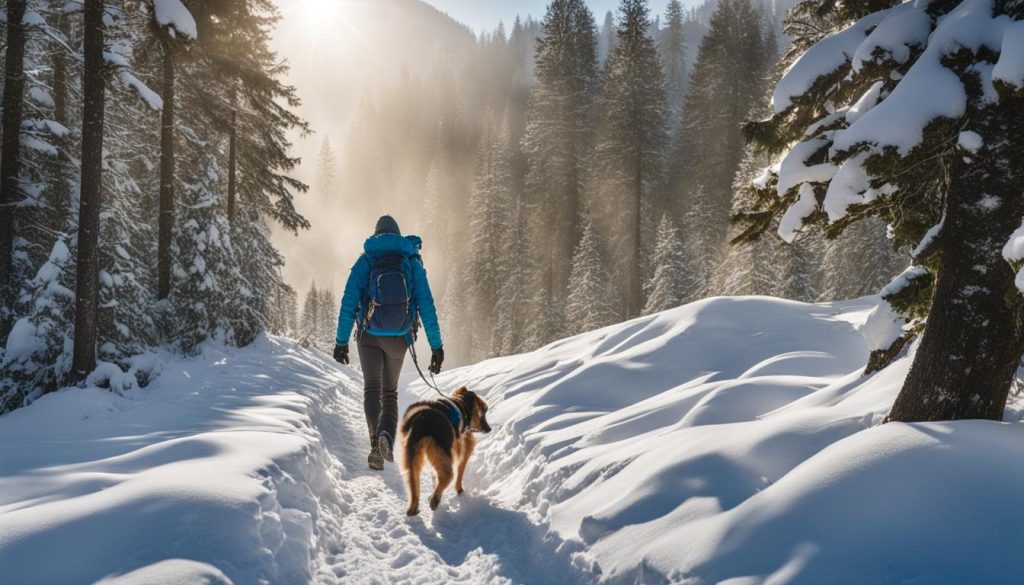
Table: Cold Weather Safety Tips for Dogs
| Tips | Description |
|---|---|
| Dress your dog in protective gear | Protect your dog’s paws with boots and provide extra warmth with sweaters or jackets for dogs with short hair or smaller breeds. |
| Monitor wind chill | Take wind chill into account and adjust outdoor activities accordingly. Shorten walks or find alternative indoor activities if the wind chill makes it too cold for comfort. |
| Be aware of your dog’s limits | Pay attention to your dog’s signals of discomfort and fatigue. Respect their limits and bring them indoors to a warm environment if necessary. |
| Know the signs of hypothermia and frostbite | Familiarize yourself with the signs of hypothermia and frostbite in dogs. Seek veterinary attention immediately if you notice any symptoms. |
Importance of Knowing Your Dog’s Limits
In order to ensure the safety and well-being of your dog during cold weather activities, it is vital to know and understand their individual limits. Each dog is unique, with varying tolerance levels to cold weather, and it is essential to pay attention to their signals and adjust activities accordingly. Knowing your dog’s limits can help prevent discomfort, hypothermia, and frostbite, ensuring that they can still enjoy outdoor adventures while staying safe and comfortable.
One way to gauge your dog’s tolerance to cold is by observing their behavior and physical cues. Signs of discomfort may include excessive shivering, lifting of paws, or exhibiting signs of fatigue. These indicators suggest that it may be time to shorten the duration of walks or bring your dog indoors to a warm environment. By recognizing and respecting these signs, you can prevent your dog from being exposed to extreme cold conditions, which could lead to potential health issues.
Additionally, factors such as breed, size, age, and overall health can impact your dog’s ability to withstand cold weather. Some breeds, such as German Shepherds, St. Bernards, and Akitas, are better equipped with thick coats that provide insulation and protection against low temperatures. On the other hand, small dogs or those with short hair may have less natural insulation and require additional protection, such as boots or jackets, to stay warm. Understanding your dog’s specific needs based on their breed and physical characteristics can help you make informed decisions about outdoor activities in cold weather.
Table: Breed-specific Cold Weather Tolerance
| Breed | Cold Weather Tolerance |
|---|---|
| German Shepherd | High |
| St. Bernard | High |
| Akita | High |
| Chihuahua | Low |
| Greyhound | Low |
Furthermore, you should take into consideration any pre-existing health conditions that your dog may have. Dogs with arthritis or hip dysplasia, for example, may experience increased discomfort and stiffness in cold weather. In such cases, it is advisable to keep your dog indoors where the environment is warm and comfortable. Providing alternative indoor activities, such as puzzle toys or mental stimulation games, can help keep their minds and bodies active while minimizing the risks associated with cold weather.
By knowing and respecting your dog’s limits in cold weather, you can ensure their safety and well-being during outdoor activities. Monitoring their behavior, understanding their specific needs, and providing appropriate protection and care will enable your dog to enjoy the great outdoors while staying comfortable and healthy.
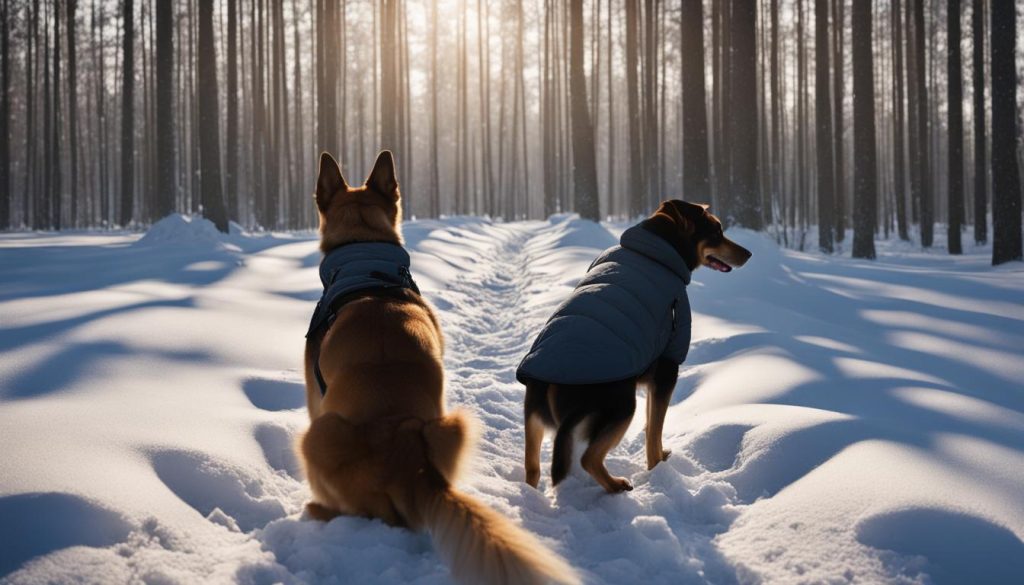
Adapting Outdoor Activities in Challenging Weather Conditions
When it comes to outdoor activities with dogs, weather conditions can sometimes be unpredictable and challenging. In such situations, you should adapt and modify your activities based on the prevailing weather conditions. By doing so, you can ensure the safety and well-being of both you and your furry friend.
Extreme cold temperatures or low wind chills can pose significant risks to dogs. If the ambient temperature drops below freezing or the wind chill is extremely low, it is advisable to shorten the duration of walks and find shelter if needed. Prolonged exposure to harsh conditions can lead to discomfort, hypothermia, or frostbite. Therefore, it is good practice to pay attention to the weather forecast and make informed decisions about outdoor activities accordingly.
“When preparing for outdoor activities in challenging weather conditions, always prioritize safety and comfort for both you and your dog.” – Pet Safety Expert
In addition to extreme cold, other weather conditions such as storms or low visibility can also impact outdoor activities. During such conditions, it is safer to stay below treeline, where navigation is easier and the risk of losing your dog in whiteouts is reduced. By staying aware of the weather conditions and adjusting your plans accordingly, you can minimize potential risks and ensure a more enjoyable experience for both you and your four-legged companion.
To put it simply, adapting outdoor activities based on weather conditions is an essential aspect of responsible dog ownership. By prioritizing safety, monitoring the weather forecast, and making informed decisions, you can continue to enjoy outdoor adventures with your dog while ensuring their well-being at all times.
Table: Adapting Outdoor Activities in Challenging Weather Conditions
| Weather Condition | Adaptation |
|---|---|
| Extreme cold temperatures or low wind chills | Shorten the duration of walks, find shelter if needed |
| Storms or low visibility | Stay below treeline for easier navigation |
| Other hazardous conditions (e.g., ice, strong winds) | Assess risks and adjust activities accordingly |

Guidelines for Walking and Exercising Dogs in Cold Weather
When it comes to walking and exercising dogs in cold weather, you should consider the temperature, breed, size, and overall health of the dog. While there are no set rules for the exact safe outdoor temperature, general guidelines suggest that most healthy medium or large dogs can walk for 30 minutes if the temperature is above 20 degrees F. Smaller dogs may need to limit their walks to 15 or 20 minutes in temperatures between 20 to 32 degrees F. You might want to assess the conditions and adjust outdoor activities accordingly to prevent discomfort, hypothermia, or frostbite. In cases of extremely low temperatures, it is recommended to keep all dogs indoors and provide alternative indoor activities for mental and physical stimulation.
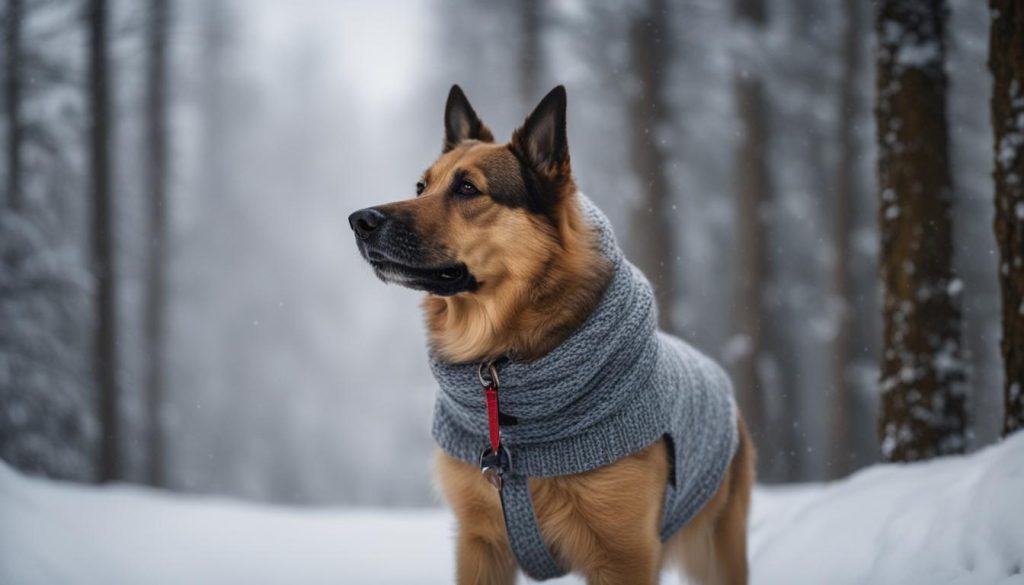
“You should be mindful of your dog’s comfort and safety during cold weather walks. Pay attention to signs of discomfort or distress such as shivering, lifting paws, or excessive lethargy. Adjust the duration and intensity of outdoor activities based on your dog’s tolerance and the weather conditions. To put it simply, it’s always better to err on the side of caution and prioritize your dog’s well-being.”
When venturing out for a walk in cold temperatures, it is advisable to dress your dog appropriately. Consider using dog boots to protect their paws from harsh surfaces and to prevent ice and snow accumulation. Additionally, dogs with short hair or small breeds may benefit from wearing a sweater or jacket to provide extra warmth. These protective measures can help dogs maintain their body temperature and enjoy outdoor activities in colder temperatures.
Finally, it is essential to be aware of your dog’s limits and adjust activities accordingly. Every dog is unique, and individual factors such as breed, size, age, and overall health play a role in their tolerance to the cold. Monitoring your dog’s behavior and well-being during cold weather walks is crucial. If your dog shows signs of discomfort or fatigue, you should bring them indoors to a warm environment and provide alternative activities for mental and physical stimulation.
Ensuring Exercise and Mental Stimulation for Dogs in Inclement Weather
When the weather outside is too harsh for outdoor activities with your furry friend, there are still plenty of ways to ensure they get the exercise and mental stimulation they need. Indoor activities can provide a fun and engaging alternative for dogs during inclement weather. Interactive toys, such as treat puzzles or chew toys, can keep them entertained and mentally stimulated. These toys challenge dogs to problem-solve and work for their rewards, keeping their minds sharp even when they can’t explore the great outdoors.
Obedience training is another excellent indoor activity for dogs. Not only does it provide mental stimulation, but it also strengthens the bond between you and your furry companion. Basic commands like sit, stay, and lie down can be practiced indoors, and you can even teach them new tricks to keep their minds engaged. Consider joining a virtual or in-person obedience class to learn new training techniques and keep your dog’s mind active.
For dogs that require more physical exercise, indoor agility exercises can be a great option. Set up obstacle courses or use household items like chairs and pillows to create a fun and challenging course for your dog to navigate. This not only provides them with physical activity but also helps improve their coordination and agility. Just make sure to clear enough space in a safe area of your home to set up the course.
| Outdoor Activities for Dogs in Winter | Potty Breaks for Dogs in Cold Weather |
|---|---|
|
|
Even during inclement weather, please ensure that your dog has regular potty breaks. If going outside isn’t an option, create an indoor potty area using pee pads or an indoor grass patch. This provides a designated spot for your dog to eliminate and helps maintain their potty training routine. Additionally, consider using a pee pad holder or using dog diapers if your dog needs to stay indoors for an extended period.
To put it simply, while inclement weather may limit outdoor activities, there are still plenty of ways to keep your dog active and engaged indoors. By providing a variety of mental and physical stimulation, you can help ensure that your furry friend stays happy and healthy, even when the weather is less than ideal.
Final Thoughts
In conclusion, determining the ideal temperature for dogs to hike or walk outside in cold weather is not a one-size-fits-all answer. Factors such as wind chill, breed, size, age, and health all play a role. You might want to pay attention to your dog’s signals and adjust their activities accordingly.
Veterinarians suggest that most healthy medium or large dogs can walk for 30 minutes if the temperature is above 20 degrees F, while smaller dogs should limit their walks to 15 or 20 minutes in temperatures between 20 to 32 degrees F. However, you should note that if the temperature drops below 0 degrees, it is advised to keep all dogs indoors.
Puppies and older dogs are particularly sensitive to the cold, and dogs with certain physical conditions or shorter coats may require additional protection such as boots or jackets. You might want to be aware of signs of discomfort, hypothermia, and frostbite in dogs and to adjust their activities accordingly.
By following these guidelines, monitoring weather conditions, and providing alternative indoor activities when necessary, dogs can continue to enjoy outdoor adventures while staying safe and comfortable. As responsible pet owners, it is our duty to prioritize the well-being and safety of our canine companions in all weather conditions.
FAQ
How cold is too cold for dogs to hike or walk outside?
The ideal temperature for dogs to hike or walk outside depends on factors such as wind chill, breed, size, age, and health. You should monitor your dog’s signals and adjust activities accordingly.
What are the factors affecting safe outdoor temperatures for dogs?
Factors such as wind chill, moisture levels, breed, age, size, and health of the dog can impact safe outdoor temperatures. You should consider these factors when determining the appropriate conditions for outdoor activities with dogs.
What are the signs of hypothermia and frostbite in dogs?
Signs of hypothermia in dogs include shivering, whining, lethargy, and slowed breathing. Frostbite signs include pale or blue skin in areas such as the tail, paws, and ear tips.
What protective gear can be used for cold weather hiking?
Dog boots can protect dogs’ paws from cold surfaces, ice, snow, and salt. Sweaters or jackets can also provide extra warmth, especially for dogs with short hair or smaller breeds.
Do different breeds have different tolerances to cold weather?
Yes, certain breeds have thicker coats and better tolerance to cold weather, while small dogs or dogs with short hair may have less natural insulation. Adjustments should be made accordingly to ensure their comfort and safety.
How should dogs with pre-existing health conditions be managed in cold weather?
Dogs with health conditions like arthritis or hip dysplasia are more affected by the cold. They should be kept indoors in a warm environment and provided with alternative indoor activities for their well-being.
What are some tips for cold weather safety for dogs?
Pay attention to your dog’s signals, dress them in protective gear, monitor for signs of discomfort or hypothermia, and adjust activities accordingly. Taking proactive measures can help ensure their safety.
Why is it important to know your dog’s limits in cold weather?
Knowing your dog’s limits helps prevent discomfort or health issues related to the cold. You should observe their signals and adjust activities to ensure their well-being.
How should outdoor activities be adjusted in challenging weather conditions?
In extremely low temperatures or stormy conditions, outdoor activities should be shortened or postponed. It is safer to find shelter and stay below treeline to avoid risks and maintain navigability.
What are the guidelines for walking and exercising dogs in cold weather?
Most healthy medium or large dogs can walk for 30 minutes if the temperature is above 20 degrees F. Smaller dogs should limit walks to 15 or 20 minutes in temperatures between 20 to 32 degrees F. Adjustments should be made based on individual factors.
How can exercise and mental stimulation be provided for dogs in inclement weather?
When outdoor activities are not possible, alternative indoor activities such as interactive toys, puzzle games, and obedience training can provide exercise and mental stimulation. Regular potty breaks should also be ensured.






